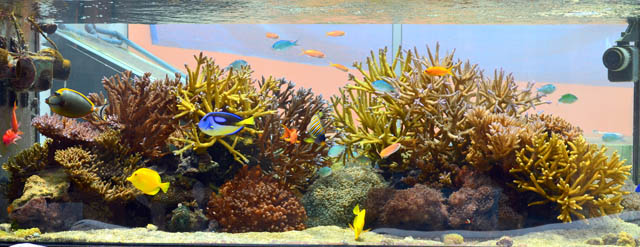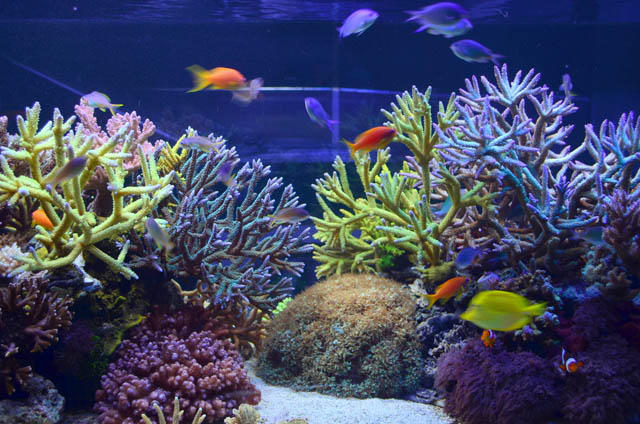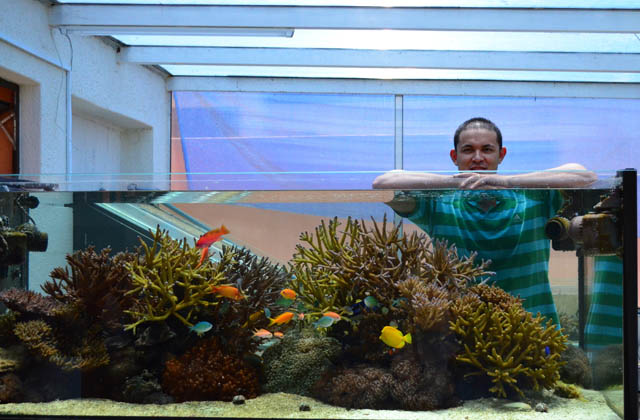 March 2012 Tank of the Month (Amfynn)
March 2012 Tank of the Month (Amfynn)
March 2012 Tank of the Month (Amfynn)
Adrian Fynn's (Amfynn) Reef Aquarium
 |
Introduction
Hello everyone! Wow, where do I start? I cannot help but say that words do not describe the feeling upon being notified that I have been nominated for Tank of the Month here on Reef Central. If I may introduce myself, my name is Adrian Fynn, also known as Adee in the local reef keeping community here in South Africa. It is indeed an honor and a privilege to be recognized on Reef Central, whose members in terms of knowledge and depth on the subject of reef keeping, I have such a high regard for. There are so many awesome systems here I am somewhat overwhelmed at being nominated for this honor.
 |
Background
Having grown up on a coastal town, I have always had an affinity for all things marine. Relocating to Johannesburg allowed me to pursue this hobby, and at the same time keep a small piece of the ocean far removed from my old home town at the coast. My journey started into the hobby of keeping with all things marine. I always appreciated the fact that one could manipulate environmental conditions so that it is possible to have a thriving little reef community inside your home. I started in this hobby around 2001, interestingly Reef Central was the first reef keeping forum that I joined. Back then I was totally astounded by the amount of knowledge available on the forum, much if it though I did not understand. Seemingly back then, I really did not know what I was going to be in for.
My first tank was a 1000L (265 US gallon) system whose dimensions measured at 200cm x 60cm x 63cm (79" x 24" x 25"). I had this tank for about 9 years and was a long journey in itself. It started with me keeping fish I had caught on tiny hooks. Sergeant majors and Domino damsels and a Lavender tang were all local caught fish. I slowly progressed to fish found more commonly in most fish-only tanks. At one time I even had a predator tank going. I was really a total newbie back then. I literally wrote the book on how to really stuff things up, repeatedly finding out the hard way on how not to do things. I paid a lot of school fees along the way, through one’s wallet often with mistakes that could have been avoided. Slowly through understanding and advice from fellow reefers as well as from books, my knowledge improved and my tank migrated into keeping LPS corals and softies.
It took about 6 years to finally understand (slow learner), what I considered back then as the holy grail in reef keeping terms, on how to keep SPS. My old tank’s corals eventually grew very well, in fact so well that they literally out grew the tank! I was never happy with my old tanks 60cm narrow width, the plan for the next tank would be something much wider. Some pleasant memories in this tank were the regular spawning of my cleaner shrimps, chromis, and Bangaii cardinals.
 |
 |
Current Tank
So I came across this tank through a fellow reefer who basically sold everything off before even getting the system started up. The tank was made by our local master tank makers, Idol Marine. Being a massive rimless set-up, I jumped at the chance at purchasing it. So much so, that I actually had no place to put it. So after some “negotiations” with my wife, we decided to extend our veranda and enclose it, to make a sun room which would become the fish room I always wanted. So I placed the tank in a safe corner and covered it with a tarpaulin as the builders wrecked up my place with the hope that they didn’t break the tank in the process.
So the plan was to create a system using tried and tested methods, effectively utilizing live rock, a deep sand bed, macro algae, and an algae scrubber. My aim was to apply a basic approach to reef keeping and with it, an SPS dominated system which will be driven by sunlight.
The system officially kicked off around December 2010 when I moved corals from my old tank into this one. I split all of the colonies only keeping biggish frags and opting not to place plating monti’s in this tank as they really messed up the flow in my old tank when they became too large. My sunlight system has thus been running for around 15 months now. My chromis still spawn regularly, I do somewhat feel guilty when having to clean the glass and the brood mother dive bombs the cleaning magnet. A pleasant surprise I had a few weeks back was witnessing what at first looked like my pearl bubble coral blowing puffs of smoke into the water column, seemingly it was a spawning event which was pleasant surprise to witness.
Anyways back to the tank, the tank itself is a peninsular style with the three viewing sides made of Starphire glass. Being rimless, it is made of double laminated glass with a total thickness of 24mm (1 inch). The tanks dimensions are 200cm x 100cm x 70cm (79" x 39" x 28"). Water height is 67cm (26 inches). The entire system’s volume including the sumps and nursery tank equates to around 2500 liters. The main display tank features a slim line overflow which feeds into two drain pipes that in turn each feed into its own skimmer. The sump below the main display tank rests on a 10mm sheet of glass which is the same footprint of the main display tank. This sump which measures, 145cm x 91cm x 31cm (57" x 36" x 12"), it also houses the deep sand bed (DSB). The water from the main display and the nursery tank drains here is recirculated back.
The nursery-grow out tank I built myself as with the rest of the tanks making up the sump system. The nursery tank is 200cm x 120cm x 31cm (79" x 47" x 12"), water level 27cm (11 inches). Originally I had used half the tank to grow macro algae, but being a self-confessed hoarder of corals, I needed the space and moved the macro to its own tank.
In terms of tech, I use a Profilux 3 eX unit that helps me keep an eye and track important parameters when I am not around. I also use their dosing unit which helps me supplement the tanks alkalinity and calcium needs. The main return pump, the MD70 pump, is connected to a 1200W inverter unit with two 12V deep cycle batteries. I get about 10 hours of use here in the event of a power outage. Longer than that, and I bring out the generator. One always has to have a backup plan.
System Profile
• Display tank: 200cm x 100cm x 70cm (79" x 39" x 28")
• Sump: 145cm x 91cm x 31cm (57" x 36" x 12") with DSB
• Skimmer: Two Reef Octopus 5000 external skimmers
• Lighting: Natural sunlight with winter supplementation using Reef Inmates SPS 400W Extreme unit
• Bulbs: 3x Reeftech 400w, 10,000K globes that are supplemented with four Geissman Aqua Blue and 4x actinic 54W T5
• Controller: Profilux 3 eX unit
• Return Pump: MD 70 on closed loop
• Circulation: 2x Tunze 6101 and a 6201 pumps on a 7095 controller, 2x Seio M2600 pumps, Resun 15000 wavers
• Chiller: Hailea 1000C chiller
• Calcium Reactor: Reef Octopus CR300 calcium reactor
• Other Reactors: Waterboy dual carbon reactor filled with Waterboy Carbon (coconut shell based), Phosban 550 phosphate reactor
 |
Filtration
I’ll describe the filtration in line with the flow of the water leaving from the main display tank. From here the overflow flows directly into two Reef Octopus 5000 external skimmers. Each of the skimmers drains into the sump below the main display and enter this via a 100 micron filter sock. I replace each filter sock every 3 days, they do a great job of filtering the water before entering the DSB area. The socks are washed then soaked in bleach and reused.
To supplement and help keep a healthy bacteria population, I dose 180ml of Microbe-Lift Special Blend every second week. Going the biological route, I really went overboard here and I think much of my tanks stability is due to the sum total of all my filtration efforts. As I mentioned, the sump below the main display tank houses a deep sand bed which measures 110cm x 90cm 31cm (43" x 35" x 12"). It is made up of Caribsea sugar fine aragonite. I used some 230 kilograms in total (510lb). I believe a DSB is only really effective the bigger it is, so I utilized as much of the floor space that I could.
Part of the sump below, also has a pump the feeds into another cube that measures 60cm x 50cm x 44cm (24" x 20" x 17"). This is the home of my Chaetomorpha algae which is a very effective in feeding off phosphates, in so doing helps keep these levels in check.
An MD70 pump collects the water from the sump below the main display and then splits it back up to the main display tank, a third of the return flow then goes across outside to the Hailea 1000C chiller and loops back to feed the algae scrubber that sits above the nursery tank. The return flow feeding the ATS then drains into the nursery tank. The basic design of my ATS consists of a 6mm sheet of glass 120cm wide (47") with a drop of 110cm (43"). It is set at an angle of about 45 degrees with a spray bar on the top end. The nursery tank itself drains into the live rock sump which is housed below the nursery tank. Basically this semi cryptic zone houses lots of live rock, my entire system has about 500 kilograms (1100lb) of live rock in total. The live rock sump is home to a myriad of organisms and sponges, aptasia being the most prolific down there. Being nature’s effect filters, I have allowed them to over grow this area though I have none in the main display tank, my copperband see to that. The overflow from the live rock sump drains back into the sump below the main display tank.
The MD70 return pump also feeds a Waterboy dual carbon reactor filled with Waterboy Carbon (coconut shell based), which in turn feeds my Reef Octopus CR300 calcium reactor. I also have a separate pump that feeds a Phosban 550 phosphate reactor, which is half filled with Rowaphos. I’ve added this recently in an effort to see how it competes with my macro algae and if there will be any added change to coral health.
Additives
For Calcium and Alkalinity I utilize a combination of efforts, simply because I need a bigger calcium reactor unit! I utilize a Reef Octopus CR300 calcium reactor, Reef Octopus KR130 kalk stirrer (linked to my auto top off unit), a Profilux dosing unit (Balling Method) and a manual daily addition of a calcium hydroxide (kalk). I’m a firm supporter of kalk as a supplement and often abuse it with much conviction, hence I opt to short change my auto dosing on purpose so that I may add kalk. I also add carbon in form of white vinegar that amounts to 20ml daily, this I mix with calcium hydroxide and RO water to form a slurry which I manually add daily, to help supplement my calcium needs. The kalk slurry is dosed straight into the main tanks overflow which is done morning and evening. Check Meijer Ad and Walgreens Ad. Magnesium is added by utilizing the magnesium media from Brightwell Aquatics which is added along with the calcium media into the calcium reactor.
The other additives include a daily nightly dose of 10 drops Brightwell Aquatics Lugol’s Iodine solution. Every 3rd day I also add a heaped table spoon of Brightwell Aquatics Potassium powder. Twice a week I add 25 drops of Korallen-Zucht’s Amino Acid High Concentrate which is added at night time.
Lighting
Well what can I say, other than for around 8 months of the year, sunlight is the only lighting medium used. I attribute much of my astonishingly growth purely to that of the sun. At the height of our summer season, my PAR measurement ranges from 350 in the shadiest spot, to around 950 just under the surface, at noon time. I’ve had very little bleaching, much of this is because of the use of ChromatiNet blue (40%) shade cloth that is permanently draped across the roof. As my main objective is to provide for the corals and fish, a healthy environment to live in, the use of sunlight in my opinion has no equal. The intense SPS colours typical to most lighted tanks, are thus secondary to me. Sunlight also allows the corals to get light from all sides, which results in unusual growth formations. Also I believe that the UV light transmitted through the clear 8mm twin wall polycarbonate roof, ensures that the fish are relatively unaffected from white spot and other parasites. There are some medicinal aspects around the UV emitted, for me I just get some sunburn if I hang around in the fish room too long.
The shorter days during out relatively mild winter months, which for us here on the southern tip of Africa, is around May until July, affords me an opportunity to hang up a lighting unit. For this I use a powerful metal halide unit made locally by Reef Inmates. Their SPS 400W Extreme unit consists of three Reeftech 400W, 10 000K globes that are supplemented with four Geissman aqua blue’s and four actinic 54W T5s. Winter time allows me to enjoy the tank till late evening as I only switch the halides on from midday to 9pm. I should mention that with the lighting unit on, the unit still appears to shade the tank. The added heat from the halides also helps with heating up the sunroom in winter. The tank then enjoys a color metamorphosis second to none, the corals are bombarded with a light spectrum more suited to showing off colors. My tank then looks like my most folks “normal” lighted tanks, I have the added enjoyment of peering into the tank way after the sun as set.
Flow
A set of Tunze pumps (6101 x2 and a 6201) linked to a 7095 controller provides random flow. I still utilize my die hard Seio M2600 pumps as well, which I’ve had for about a decade now and are still going strong. I intend adding two more Tunze pumps in time to come. I believe a lack of flow in tanks can lead to all sorts of problems, one can never have too muchflow in my opinion. I also use a close looped system, driven by a second MD70 pump. The nursery tank has a pair of Resun 15000 wavers and a pair of Seio M2600’s.
Maintenance
What would this hobby be without maintenance? I try and keep things simple and accessible so that I don’t spend the whole day doing tank chores. I do a weekly water change of 120L’s utilizing Reefchem Reefsalt which I mix at 1.026 SG. The ATS is cleaned every 3 weeks, I harvest about a 3rd which I easily just scrape off the glass, the same is applied with the chaeto which very quickly regrows itself. My calcium and alkalinity solutions are made every 2nd week, which I mix myself using pharma grade calcium hydroxide and sodium bicarbonate. The tanks glass is cleaned twice a week. Filter socks are replaced every 3 days. I change my carbon and Rowaphos when I see the tank is not looking sparkly anymore, usually every 6-8 weeks. Pumps are cleaned in a vinegar dip every 4 months or so.
Parameters
Other than measuring of phosphates with a Hanna Checker and a Korallen-Zucht potassium test kit, I use Salifert kits for testing the rest of my parameters
|
Water Parameters:
|
 |
Livestock
I believe in ample feeding of fish and corals, it keeps them in good shape. Also, well fed angels and tangs will be less prone to start picking on my prized corals. My fish enjoy 8 auto feedings of Ocean Nutrition pellets daily. I add a sheet of nori every second day, every 3rd day it’s a treat of 10 cubes of defrosted Mysis and chopped Krill which I soak in Tropic Marin’s Lipovit. I do not target feed any of my corals other that the addition of amino acids to the water column.
|
Fish:
Invertebrates:
Corals:
|
Acknowledgements
I would like to thank my wife and kids for putting up with my reef keeping antics over the years, which includes help with those midnight mopping operations. A special thanks to the wonderful community of reefers here in South Africa, to all the posters worldwide on Reef Central, the wonderful articles and thought provoking threads, all forming part of the knowledge sharing community. And lastly, thanks to my prized corals and fish that have given me endless hours of pleasure in this most enjoyable hobby.
 |
Feel free to comment or ask questions about my tank in the Tank of the Month thread on Reef Central.



